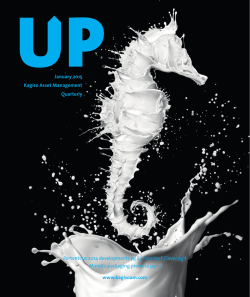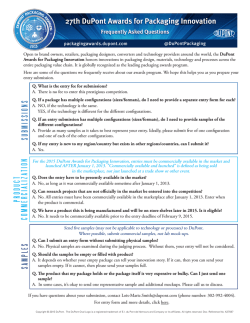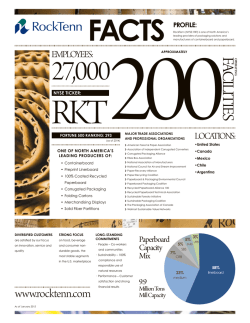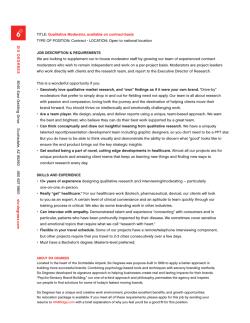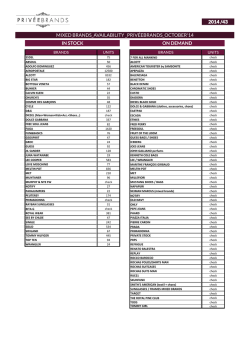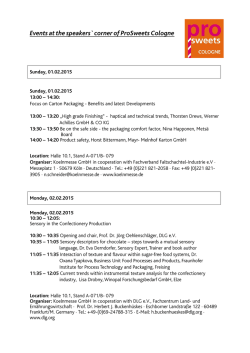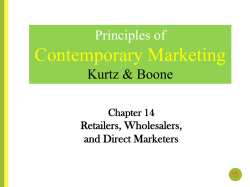
download - Kagiso Asset Management
January 2015 Kagiso Asset Management Quarterly Portentous 2014 developments pg 1 Four-leaf Clover pg 4 Mondi’s packaging prowess pg 13 www.kagisoam.com 1 Portentous 2014 developments 4 Four-leaf Clover Gavin Wood Dirk van Vlaanderen 8 Clothing retailers: winter is coming 13 Mondi’s packaging prowess 17 Performance table Unconventional thinking Simon Anderssen Rubin Renecke Portentous 2014 developments Gavin Wood - Chief Investment Officer After persistent trends and low volatility since the financial crisis, 2014 presented market dislocations and structural changes that we believe have important implications for the course of financial markets, whose participants seem somewhat complacent since ‘momentum’ has been the winning strategy for so long. We highlight some of these dislocations and changes below. 1 Portentous 2014 developments The US passed on the QE baton Foreigners began selling SA bonds via the purchase by central banks of financial instruments from foreigners sold R71.7 billion of bonds in 2014. Coinciding with Quantitative easing (QE), injecting liquidity into the economy the private sector, has been executed on a grand scale since the financial crisis (see chart below) - at a time of near zero interest rates in the world’s largest economies. After many years of foreign inflows into our bond market, these outflows, the rand depreciated by 9.3% (to the US$) to its worst level since 2001. Receding foreign liquidity will make our government’s budget deficit more difficult to finance. The US Federal Reserve has purchased US$3.7 trillion between Emerging market equities also saw foreign outflows of magnitude of this intervention is staggering, given that the US into SA, at R13.3 billion, were positive. However, this may have November 2008 and October 2014 (QE3’s conclusion). The economy (GDP is US$17.6 trillion) and bond market (103% public debt:GDP) are the world’s largest. The real economy benefits of US QE have, in our view, been mixed and of diminishing effect through time, but the impact on asset prices has been massive. US$25 billion in 2014, while, in contrast, foreign equity inflows had more to do with internal problems in our emerging market peers (Russia, Brazil, Turkey, Thailand) than the absolute prospects for our companies. China’s economy decelerated further Having grown GDP at rates of 8%-10% pa for over a decade In 2013, the Bank of Japan began its enormous QE programme (slowing to below 8% in 2013), China’s growth rate headed and the European Central Bank tentatively began asset towards the 7% level in 2014. Growth is likely heading lower as purchases in 2014, with widespread expectations of significant the economy needs to absorb excess capacity, deleverage and sovereign bond purchases to come. This significant structural change highlights the better state of the US economy and has precipitated a sharp strengthening of the US dollar against the yen and the euro. The net effect should be a tightening of rebalance away from fixed investment. China’s property activity slowed in 2014, housing prices declined and new residential construction fell. Limited fiscal policy (infrastructure investment) and monetary policy (lower bank reserve requirements and an global liquidity conditions, given the relative magnitude of the interest rate cut) stimulus measures were introduced. QE programmes, which should be negative for asset prices. Different directions for central bank balance sheets Central bank assets as a % of GDP 60 50 Bank of Japan 40 European Central Bank Bank of England 30 US Federal Reserve 20 10 2010 2011 2012 2013 2014 Source: BCA Research and Kagiso Asset Management research Commodity prices fell sharply up some 20% of imports. The large relative oil price decline commodity consumer, came as 2014 saw an increase in supply impact and, together with lower maize prices, will dampen price The growth deceleration in China, the world’s largest non-oil of many of the commodities it imports. The result was large commodity price falls, with iron ore and oil prices almost halving and thermal coal down 22%. Precious metals were little changed in 2014 off already low levels as supply was curtailed. The oil price decline is particularly important for the world (graph below) should result in a slightly positive trade balance inflation, enabling the SARB to raise rates more slowly. In South Africa Local developments of particular importance for financial markets were: the start of the SARB rate hiking cycle; economy as it is the largest commodity traded by value. The National Treasury announcing ‘austerity measures’ in its cause of the price decline was increased production from North America at a time of weak demand from Europe and China and growing use of substitutes (natural gas and renewables), with OPEC making no change to their production intentions. October mini-budget in the form of an expenditure ceiling and imminent tax rises; major splits in organised labour with the NUMSA expulsion from Cosatu and the emergence of non-aligned AMCU, whose perceived success with its platinum mine strike is These material commodity price declines will have significant fuelling a major recruitment drive from established unions implications for their respective consuming and producing in various other sectors; and countries and companies. Iron ore producers, eg Brazil and Australia, will see export revenues decline. Large net oil exporter economies such as Saudi Arabia, Russia, Nigeria, Angola, Columbia, Mexico and Venezuela will struggle as they are very concentrated around oil production. Oil price falls will particularly benefit large net importers, such as Europe and Japan. South Africa’s exports are dominated (roughly 60%) by iron ore, thermal coal, platinum group metals and gold, while oil makes the demise of African Bank Investments, which should serve to reduce the extortionate returns earned by unsecured credit providers in SA, to reorganise the furniture retail industry and to remind bond and preference share investors to consider credit risk. Given these structural changes, 2015 has begun with raised market volatility and our clients’ portfolios are therefore positioned for a very different environment to the one that has prevailed in recent years. Falling commodity prices 12 130 120 Rand US$ per tonne 110 100 10 90 80 9 70 60 8 Dollar commodity prices based to 100 11 Rand dollar (LHS) Platinum Gold Oil (Brent) Iron ore Thermal coal 50 7 Dec 11 2008 2013 Jun 12 Global average Dec 12 Jun 13 Dec 13 Jun 14 40 Dec 14 Source: Bloomberg and Kagiso Asset Management research Four-leaf Clover Dirk van Vlaanderen - Investment Analyst Clover has a rich history of dairy and consumer product manufacturing over the last century in South Africa. The company converted from a co-operative to a public company in 2003 and listed on the JSE Securities Exchange in December 2010. 4 The Clover brand is a well-known household name in generates around half of the beverage revenues and has portfolio to include a wide range of dairy-related and beverage include Quali (acquired from AVI in 2012), Krush (fruit juice), South Africa and, over the years, the company has expanded its products. The table below shows the different products by operating division, while the chart on the next page (left) gives an indication of the revenue and operating profit contribution of each division. shown excellent growth over recent years. Other brands Manhattan (iced tea) and the recently acquired Nestlé brands of Nestlé Pure Life (bottled water) and Nestea (iced tea). Apart from a broad portfolio of brands in attractive categories, it is worth noting that Clover has very strong market share Dairy fluids is Clover’s largest division by revenue (48% of group) but contributes significantly less to operating profit (22%) given the lower operating margins in milk. This division mainly consists of fresh and long-life milk produced under the Clover brand, as well as Super M in the flavoured milk category. Dairy concentrate products is a much smaller business, positions within these categories. The chart on the next page (right) highlights the strength of Clover’s brand portfolio, averaging a 30% share across the majority of its key categories. Strong market share positions mean Clover generally has more bargaining power with retailers, and therefore a greater ability to increase prices in order to offset cost inflation to defend and ultimately grow operating margins. contributing 14% to Clover’s revenues, and includes the Mooi River and Butro butter brands and the Clover brand in pre-packaged cheese. Beverages makes up 24% of revenues but we estimate that this category contributes 44% of operating profit due to the higher operating margins it commands. Within this division Clover has been very successful in acquiring additional Clover is often mistaken for a ‘dairy’ company. While this is where its roots lie, the company has successfully used dairy as a platform to gain scale and has diversified through this scale into the higher-growth and more profitable beverages category. It has done this to the extent that the beverages category is now a larger profit contributor than dairy. While dairy remains important to Clover, we expect that the brands to its existing production and distribution capabilities. Tropika is an iconic dairy-based fruit mix, which company will continue to add a range of adjacent products to Products and brands per reported division Division Products Dairy fluids Fresh and ultra high temperature milk (‘UHT’/ ‘long life’), cream, maas, yoghurt and custard Dairy concentrate products Butter, spreads, pre-packed cheese, condensed milk and milk powders Beverages Juices, iced tea and bottled water Ingredients Bulk condensed milk, creamers and powdered milk Distribution services Proprietary and third party storage and distribution services and in-store merchandising Brands Source: Company data and Kagiso Asset Management research Four-leaf Clover further bolster its current portfolio and gain additional economies of scale. Distribution platform is a key competitive advantage create sufficient capacity within the production and distribution network to support Clover’s growth plans, which is fundamental to the company’s investment case. A lesser-known fact about Clover is that it has the largest Clover is therefore well positioned to benefit from any 14 900 points), delivering mainly its own brands but also third distribution platform and is currently looking to grow chilled distribution network in South Africa (over party products (such as Enterprise and Red Bull). This vast geographic reach and high frequency of deliveries remains a key competitive advantage. Clover is also one of only a few companies to do in-store merchandising for its own and third-party products. This is an advantage as it helps the company to ensure the best product placement in the stores and to combat retailers pushing their own label products over the Clover brands. Clover has been investing in its growth infrastructure for many years. Project ‘Cielo Blu’, which began in 2010 and was completed in 2014 at a total cost of R340 million, was a major efficiency initiative. The project addressed historical inefficiencies in the supply chain network and has resulted in a cumulative R100 million of production and distribution savings in the business. Most importantly, Cielo Blu was implemented to 2014 divisional breakdown of sales and operating profit higher revenues and lower distribution costs - given Clover’s significant scale. A good example of this is the acquisition of Nestlé’s beverage brands in 2013, which Clover has already turned profitable after years of losses within the Nestlé stable. Divorcing Danone main product offering. Danone currently dominates the yoghurt market in South Africa with a 44% market share 2014 market share per key category 80% 17.3% 70% 60% 13.0% 50% 40% 30% 20% 48.1% Source: Company data and Kagiso Asset Management research Iced tea Water brands Ingredients Dairy fruit mix Dairy concentrate products Distribution services 0% Pure fresh juices Operating profit Pre-packed cheese 10% 22.2% Sales yoghurt or custard as this competed directly with Danone’s 3.1% 44.4% 40% Under the agreement, Clover has not been allowed to produce Feta cheese 24.1% custard, sales and merchandising services, and distribution. Maas 60% raw material procurement, manufacturing and packaging of Cream 14.1% services to Danone, including the supply of raw milk and other Flavoured milk 80% in South Africa since 1995. Clover currently provides a range of UHT milk 3.3% 10.4% Dairy fluids Beverages would benefit from a wider distribution platform resulting in Fresh milk 100% 0% internally as well as through acquisition. Acquisition targets French dairy giant, Danone, and Clover have been collaborating Invested for growth 20% additional brands and products that it can add to its Source: Beverages data, SAMPRO, BofAML and Kagiso Asset Management research (pie chart below), which is mainly through its ubiquitous Shifting the business mix through the Ultramel brand. This 20-year partnership comes sound strategic rationale given the higher growth and Nutriday brand. It is also the leading producer of custard to an end in January 2015 and Clover is set to embark on a new adventure in the previously off-limits categories of yoghurt and custard. In order to gain immediate scale and expertise in yoghurt, Clover acquired Dairybelle’s yoghurt business in 2014 for R125 million, which included a yoghurt manufacturing facility in Bloemfontein and the well-known ‘Fruits of the Forest’ brand. Clover plans to refresh this brand in January 2015 and enhance its geographic reach through its superior distribution platform, thereby increasing its market share above the 7% level it currently enjoys. The second part of the move into yoghurt involves launching the Clover brand as a premium yoghurt to complement Dairybelle’s middle price point positioning. custard and yoghurt in the next few years, with the ambition to increase this to 20% over time. We estimate a 15% share in both would add R600 million to Clover’s revenue and been the slowest growing segment over the past five years (with volumes up 3%), while yoghurt and some of the beverages categories have grown volumes between 5% and 11% pa. Operating margins in these adjacent categories are also very attractive and can be as much as six times the 2% - 3% that Clover generates from milk. Milk will remain core to Clover given the importance it holds for group scale, but the shift into adjacent categories enhances the group’s growth and profitability profile. Unique asset Clover’s strong and diversified brand portfolio and leading with the potential to create significant value through further organic growth as well as through acquisitions. We believe the current share price undervalues the future potential of this behalf of our clients. Annual market volume growth rate per category 12% 5-year average annual growth rate* (2009-2014) traditional milk offering. As shown in the chart below, milk has strategy and we therefore hold Clover in our portfolios on R90 million (a 31% increase) to operating profits. 2014 SA yoghurt market share 11% 10% 9% 8% 9% Other 20% 7% 6% 5% Retailer own label 21% 5% 44% 7% 3% 8% 2% 0% profitability profiles of these categories relative to Clover’s distribution network combines to create a unique platform Management are targeting a 15% market share in both 4% The shift into beverages and now yoghurt and custard has Milk Yoghurt Flavoured Maas milk Iced Tea Bottled water Juice * Maas 2-year average annual growth rate Source: BofAML and Kagiso Asset Management research Clothing retailers: winter is coming Simon Anderssen - Investment Analyst South Africa’s four large listed clothing retailers (the Listed Four1) have traded remarkably well through the country’s recession and low economic growth environment since 2008. Over the six years to June 2014, clothing retail sales have increased 8.8% pa, while consumers’ nominal disposable income has increased in line with nominal GDP growth at around 8.2%. The Listed Four have outperformed, with sales growth of 11% pa. Management and shareholders have been rewarded with compounded growth in the combined market value of 32.5% pa. 1 Woolworths, Foschini Group, Truworths and Mr Price 8 There are structural and cyclical reasons for this strong in August 2014, total unsecured consumer credit has continued middle class and the expansion of the social grant system are It is revealing that total consumer credit outstanding has not outperformance. Continued positive growth in South Africa’s examples of trends that have structurally increased the country’s potential consumption expenditure. Simultaneously, the 2 explosion in consumer credit has provided a cyclical boost to discretionary spending. Significant market share losses from Edcon, the country’s largest clothing retailer, are another reason for the Listed Four’s relative outperformance. Goodbye summer We do not believe that the above forces can continue to sustain strong clothing retail sales growth because South Africa’s low-growth economic outlook is not supportive of the private sector employment growth that is the key to an expanding middle class. Furthermore, a large fiscal deficit will make it difficult for government to continue to be the primary marginal employer going forward and growth in the number of social grant recipients will be modest from here. Notwithstanding the sharp contraction in the growth in personal loans since September 2013 and African Bank’s failure to increase as consumers shift to credit cards and overdrafts. yet declined in absolute terms and remains very high as a proportion of disposable income (left chart below). In other words, consumers have not yet reduced debt levels after a three year credit binge. Based on these factors, we firmly expect modest or negative real (after inflation) clothing retail sales growth over the next few years as the level of sales normalises to consumers’ true spending power. Since we expect wages, rental and utility expenses for retailers to continue increasing in real terms, compounded by current commitments to open new space, operating expense growth for the retailers is likely to grow faster than retail sales. This is negative for future profitability of the Listed Four. To defend against costs outgrowing sales, the Listed Four can gain market share by increasing sales faster than the overall market. We believe that this will be a challenge. 2 Personal loans, credit cards, overdrafts and other unsecured household credit Consumer debt to disposable income Change in market share: 2008 to 2014 18% 3% 16% 2% 14% 12% 1.79% 0.91% 1% Average 10% 0.68% 0.71% 0.03% 0% -1% 8% -2% 6% -3% 4% 2% -4% 0% 1994 1996 1998 2000 2002 2004 2006 2008 2010 2012 2014 -5% Source: South African Reserve Bank and I-Net -4.12% Edgars Woolworths Foschini Truworths Mr Price Group Other Source: Stats SA, company reports and Kagiso Asset Management research Clothing retailers: winter is coming Dividing the pie with Edcon’s target market. Mr Price’s aggregate share of an underperformer. The underperformer over the last six years and Foschini Group. Retail is a zero-sum game and for every outperformer there is has been Edcon, which has lost 4% market share since delisting in a private equity buyout in 2008. The Listed Four have benefited disproportionately (right chart on the previous page) from the troubles at the country’s largest retailer. Delving deeper shows that new brands or formats account for the majority of these market share gains. For instance, the Woolworths group’s stable market share over the last six years is fully accounted for by sales of its Country Road brands3. In other words, market share of the existing Woolworths brands has declined. Similarly, more than half of the market share gains achieved by Foschini Group and Truworths over the last six years have come from brands that were relatively small at the start of the period. The flagship formats Foschini, Truworths and Truworths Man have lost market share or achieved minor gains. clothing in South Africa is now comparable to Truworths Edcon’s financial position has deteriorated significantly over the last two years and we believe that a capital restructuring is imminent. The business’ operations are profitable (before interest costs) and are showing signs of marginal improvement. We expect the degree of underperformance to narrow under a revised capital structure. A final observation is that clothing sales in South Africa are concentrated in a small number of brands. The chart below shows that the market share of the 10 largest clothing brands accounts for nearly 40% of all sales. This is a much higher proportion of sales concentration than is normal in other countries. Fashion fundamentally relies on a variety of styles and designs and we expect this concentration to decline as our market matures. Brand development has been exactly the right strategy for While Mr Price’s single brand accounts for the majority of clothing sales, its strong outperformance is a combination of excellent operational execution and a relatively large overlap the Listed Four and has been very well executed by these companies. Their success proves that South African consumers have sought variety by shifting spend to smaller brands over 3 Country Road, Trenery and Witchery Market share of 10 largest clothing brands 50% 40% 30% 20% 10% Large Size of clothing market Uk ra in e Co lo m bi a Th ai la nd Ph ilip pi ne s Po la nd Sw ed en So u Af th ric a Au st ra lia Tu rk ey M ex ico Ca na da UK Ge rm an y US 0% Small Source: HSBC, Euromonitor data and Kagiso Asset Management research the last six years and we expect this to continue. Looking proportion of southern hemisphere stores to the current store - attracted by the high returns earned by South African expansion strategy. count4, an indication of their nascent southern hemisphere forward, we believe this supports our view that new entrants clothing retailers - will succeed in growing market share at Supply chain is necessary to win the expense of the Listed Four. How merchandise gets onto the shop floor will be a key The foreign contenders differentiator for clothing retailers over the coming years. For many years foreign brands entered South Africa through The Listed Four have for many years relied on fashion trends wholesale or agency agreements with local partners. This has in the northern hemisphere and the seasonal delay to ‘iterate’ changed over the last two years as large international clothing these designs for local tastes, source materials, manufacture in retailers have established local operations and corporate store the east and ship to South Africa in time for the corresponding portfolios, reflecting a significant change in strategy and a southern hemisphere season. This requires retailers to commit commitment of their capital to establish a local business. to product volumes upfront in anticipation of future demand. Entering the southern hemisphere is a significant strategic The fashion risk they have had to manage is either having decision for northern hemisphere companies. This is due to insufficient product to satisfy demand, resulting in foregone the commitment to increase design and manufacturing profits, or clearing surplus stock through season-end sales. capacity to simultaneously maintain fashion credibility across For some retailers, discounting clearance stock is their second different seasons. largest operating expense. The table below compares the Listed Four to some of the The international contenders entering South Africa are among global retailers that have entered, or intend entering South the largest global clothing retailers. They have, over many Africa. The key observation is the relative scale advantage of years, pioneered a supply chain model that provides flexibility the international companies, in terms of sales, and the low 4 Cotton On is an Australian business Comparison: international and local clothing retailers International retail companies Listed Company Inditex H&M South African retail companies Unlisted GAP Arcadia Group Listed Forever 21 Cotton On Mr Price Truworths Unlisted Foschini Woolworths ** Edcon *** 219 187 159 39 38 not available 15 10 14 12 24 Total number of stores 6 340 3 132 3 539 3 140 600 >1 300 1 079 667 2 111 259 1 163 % of stores in southern hemisphere 9 0 0 3 3 99 100 100 100 100 100 Zara H&M* Sales (in R billion) Brands trading in South Africa (partner) Incl Gap, Cotton On, Miladys, Banana Topshop Forever 21 Typo, Sheet Republic (Edcon) Factorie Street (Stuttafords) * Opening 2015 ** Data applies to Woolworths Clothing and General Merchandise division *** Numbers exclude CNA Incl Incl Uzzi, Incl Edgars, Markhams, Identity, Trenery, Daniel fashionexpress, Country Road, Red Square, Jet, Legit Totalsports Hechter Witchery Source: HSBC, company data and Kagiso Asset Management research Clothing retailers: winter is coming to frequently introduce new products and restock popular and an established store portfolio. Another competency is Response’ model is that the retailers limit the amount of of clothing sales for many South Africans. selling products in the same season. The benefit of this ‘Quick product committed to upfront, thereby reducing the risk of future clearance discounts. They are also able to respond in-season to demand and thereby able to maximise profits from their best selling items. Scale is a key advantage for a successful Quick Response supply chain and the international contenders use significantly larger production volumes to dominate global production capacity and to achieve significantly lower per-unit production costs. While the Listed Four have invested in Quick Response capabilities over the last few years, they still lag the international contenders. Instead, their advantage is deep knowledge of local tastes experience in granting credit, which is an important facilitator The seasons are changing The Listed Four have enjoyed an extended summer of buoyant consumption spending and a withering competitor (Edcon) to gain market share and achieve world-leading profitability. In our view, current high share prices do not yet reflect a reversal or non-recurrence of structural, cyclical and competitive drivers of recent performance. Looking ahead, we anticipate structurally slower consumer sales from a deleveraging consumer and increased competition to erode retail profitability. This is one of the reasons that we are not invested in any of the Listed Four. 12 Mondi’s packaging prowess Rubin Renecke - Investment Analyst While Mondi is widely known for producing office printing paper (uncoated fine paper), this global packaging company has an extensive range of other products that consumers use daily. Mondi products range from the corrugated boxes used to package new HD TVs to the microwaveable containers that hold ready-made meals to the heavy duty bags that contain cement. 13 Mondi’s packaging prowess We believe that Mondi is a compelling investment due to its packaging paper (containerboard and kraft paper) production; shares and low-cost integrated operations. An increasing focus (such as corrugated boxes and paper bags) for industrial the conversion of packaging paper into packaging products product range, track record of innovation, dominant market and consumer-related applications; and on environmentally friendly packaging, growing demand for the production of specialised flexible consumer packaging, convenience from consumers and growth in online shopping speciality films and hygiene components. all bode well for the prospects of Mondi’s products. In 2013, Mondi’s packaging and consumer products businesses Corrugated boxes are frequently used to transport consumer group revenue. Mondi’s strategy is to grow these businesses microwaves. The sides of these boxes, which often require products such as TVs, washing machines, fridges and earned revenues of €4.68 billion, representing 72% of total inner cushioning to protect the fragile contents during transit, with a specific focus on sales into higher growth emerging are made up of three distinct layers and each layer is made up markets (currently 51% of group revenue). With its main operations located in Germany, Emerging Europe (Poland, Czech Republic and Bulgaria) and Russia, Mondi of a packaging paper with specific properties. The outer paper is made of virgin or non-recycled containerboard (produced from wood pulp), as this needs to be strong. The inner layer is employs about 24 400 people worldwide. The group is fully made of recycled containerboard, which is cheaper to produce integrated across the packaging and paper value chain - from the management of its own forests and the production of pulp and paper to the conversion of packaging paper into various but is less strong because the fibres are being re-used. The centre fluted (wavy) layer, which provides the strength, is made of either virgin or recycled containerboard. products for both industrial and consumer applications. Mondi is the second largest producer of virgin containerboard Packaging and consumer products in Europe. In its production facilities across 30 countries, Mondi produces Paper bags used for bulk industrial applications (such as sugar a range of industrial and consumer packaging products, which or flour) or consumer applications (such as cement or other DIY are divided into three distinct areas: Main packaging product categories and their applications Product category Products Application examples Containerboard Virgin containerboard, recycled container board and fluting Base materials for corrugated packaging Kraft paper Sack kraft Speciality kraft Industrial bags, shopping bags, sterilised medical packaging and release liners Corrugated packaging Corrugated boxes, retail displays, dangerous goods packaging and mail order solutions Transport cases for shipping FMCGs, fruit and vegetable trays and in-store retail displays Industrial bags Heavy duty bags Cement bags, powdered chemical bags and flour, sugar and rice bags Coatings, films, liners Consumer and technical coatings, advanced films and release liners Waterproof coatings Diaper components Medical products Consumer goods packaging Stand up pouches, re-closable bags and microwaveable containers Convenience foods and products Source: Company data and Kagiso Asset Management research building materials) require high degrees of strength and durability. These bags are made using a different packaging paper grade, called sack kraft paper. While this paper is also made from wood pulp, a specific chemical process is applied to enhance its strength and durability. Other paper-based products, such as paper shopping bags, sterile medical packaging and release liners (the piece of paper covering the sticky side of a plaster), are made from specially formulated kraft paper. Mondi is the largest kraft paper and release liner producer in Europe. It is also the largest industrial bag producer in Europe, manufacturing close to four billion units a year. Additionally, the group’s flexible consumer packaging division makes a range of products including diaper elastic components and fastening systems, siliconised films for sanitary pads and re-closable plastic bags - all of which are typically made of complex, high quality, flexible plastic layers. Breaking new ground Ongoing innovation is necessary to ensure that Mondi continues to meet customers’ evolving requirements and remains ahead of its competitors. Location of operating assets Developed markets 38% Some examples of its most recent product innovations include: water-resistant containerboard to replace wax-coated products for use in high humidity and cold storage applications; anti-piracy solutions for industrial bags (such as anti-counterfeiting labels and smart identification codes); and barrier lining for soup packaging (made up of a mix of paper, polyethylene and a special protection coating), which reduces the carbon footprint of the packaging as the aluminium is removed. Asset base and markets Mondi has a high quality, low cost asset base that is primarily located in emerging European countries where production costs are lower than in Western Europe. It is able to supply both developed markets and emerging markets from this region. This is particularly important in its paper-based packaging businesses, where competition is fierce. The pie charts below shows Mondi’s exposure to emerging markets. The company has been wisely investing in high return, low risk projects over the past few years and has made some astute acquisitions at attractive prices. Sales by destination Emerging markets 62% Developed markets 49% Emerging markets 51% Source: Company data Mondi’s packaging prowess During the 2014 financial year, more than €230 million of environment. The highly technical nature of many of its has earmarked another €320 million to be invested over the market positions, provides the business with a natural capital investment projects will be completed and the group next year. These projects are largely aimed at reducing energy costs and improving efficiencies and production output. Mondi has a solid track record of delivering on projects and the group’s strong cash flows allow it to continuously invest in its plants to improve its cost position. These internal investments position it very strongly for the years ahead. products, coupled with its low cost operations and leading competitive advantage. As a result of its favourable position and despite a weak European economic environment, Mondi has generated significant returns over the last four years. As shown in the chart below, Return on Capital Employed (ROCE) has consistently been above the company’s internal target since the start of 2011. We believe that Mondi has the potential to do even better in a more benign economic environment and Competitive edge we therefore hold a significant position in this business on Due to its broad product range and record of continuous behalf of our clients. innovation, Mondi is strongly positioned to benefit from a constantly evolving global industrial and consumer packaging ROCE track record over time 20% Average = 15% Average = 10% 15% 15.0% 12.3% 10% 10.6% 15.3% 16.0% 13.6% 9.5% 7.6% 5% 0% FY07 ROCE FY08 Company internal target FY09 FY10 FY11 FY12 FY13 FY14 first half Source: Company data and Kagiso Asset Management research Kagiso Asset Management Funds Performance to 31 December 2014 Unit trust funds 1 1 1 1 year 3 years 5 years 10 years 8.2% 16.1% 15.0% -0.8% 0.7% 1 2 Since launch Launch TER 17.8% 20.9% Apr-04 1.5% 2.7% 4.1% May-11 1.5% Dec-02 1.7% May-11 1.5% 3 Equity Alpha Fund South African Equity General funds mean 10.4% Outperformance -2.2% South African Multi Asset High Equity funds mean 9.5% 8.8% Balanced Fund Outperformance 10.5% CPI + 5% 4 Outperformance Return on large deposits* Institutional funds 5 -0.5% 9.6% - -2.5% -0.1% - 17.5% 15.8% 21.6% Core Equity Fund 9.6% 20.0% 16.9% -5.8% -1.6% -0.9% 15.1% FTSE/JSE SWIX All Share Index 15.4% Outperformance Domestic Balanced Fund 6 9.1% -4.1% 21.6% 12.2% Peer median7 13.2% 15.6% Global Balanced Fund8 9.4% - -4.1% Outperformance 13.4% Peer median 9 Outperformance Sharia unit trust funds 3 Islamic Equity Fund South African Equity General funds mean Outperformance Islamic Balanced Fund South African Multi Asset High Equity funds mean Outperformance -3.4% 10.4% -3.4% 7.6% 9.5% -1.9% 12.7% -0.1% 11.1% 10.7% - 9.8% 17.8% 0.4% 5.3% -2.0% - 15.0% 18.5% 19.6% -0.1% 0.2% 15.0% 0.0% 17.8% 18.6% 12.4% - 10.1% - 15.3% -2.7% - -4.0% 7.0% 12.6% 4.5% 15.4% -7.6% 16.8% 11.0% 4.7% FTSE/JSE SWIX All Share Index Outperformance - 10.9% 9.9% 5.2% 15.1% 7.7% 10.2% 5.4% 4.2% 14.3% 10.5% -0.9% 7.8% Managed Equity Fund 13.8% 14.3% -2.0% 9.6% Stable Fund Outperformance -0.7% 8.5% Protector Fund 16.9% 19.4% 11.3% -1.2% 17.7% Sep-06 Nov-04 May-07 Jul-13 -2.4% 12.8% 12.6% -4.1% -1.7% 16.9% 11.7% 14.3% -2.6% 14.3% - - - 15.2% 17.0% -1.8% 8.9% 12.7% Jul-09 1.2% May-11 1.4% -3.8% 1 Annualised; 2 TER (total expense ratio) = % of average NAV of portfolio incurred as charges, levies and fees in the management of the portfolio for the rolling 12-month period to 31 December 2014; 3 Source: Morningstar; net of all costs incurred within the fund and measured using NAV prices with income distributions reinvested; 4 CPI for December is an estimate; 5 Source: Kagiso Asset Management; gross of management fees; 6 Domestic Balanced Fund and benchmark returns to 30 November 2014; 7 Median return of Alexander Forbes SA Manager Watch: BIV Survey; 8 Global Balanced Fund and benchmark returns to 30 November 2014; 9 Median return of Alexander Forbes Global Large Manager Watch. * Return on deposits of R5 million plus 2% (on an after-tax basis at an assumed 25% tax rate). engage in scrip lending and borrowing. Exchange rate movements, where applicable, may affect the value of underlying investments. Different classes of units may apply and are subject to different fees and charges. A schedule of the maximum fees, charges and commissions is available upon request. Commission and incentives may be paid, and if so, would be included in the overall costs. All funds are valued and priced at 15:00 each business day and at 17:00 on the last business day of the month. Forward pricing is used. Performance is measured using Net Asset Value (NAV) prices with income distributions reinvested. NAV refers to the value of the fund’s assets less the value of its liabilities, divided by the number of units in issue. Figures are quoted after the deduction of all costs incurred within the fund. Please refer to the relevant fund fact sheets for more information on the funds by visiting www.kagisoam.com. 17 Disclaimer: The Kagiso unit trust fund range is offered by Kagiso Collective Investments Limited (Kagiso), registration number 2010/009289/06, a member of the Association for Savings and Investment SA (ASISA). Kagiso is a subsidiary of Kagiso Asset Management (Pty) Limited, a licensed financial services provider and the investment manager of its unit trust funds. All information and opinions provided are for general information purposes only. They are not intended to address your unique circumstances and do not constitute advice. We recommend that you seek the relevant legal, tax, investment or other professional advice that will enable you to develop an appropriate investment strategy to suit your needs. Unit trusts are generally medium to long-term investments. The value of units will fluctuate and past performance should not be used as a guide for future performance. Unit trusts are traded at ruling prices and can 17 Kagiso Asset Management (Pty) Limited Fifth Floor MontClare Place Cnr Campground and Main Roads Claremont 7708 PO Box 1016 Cape Town 8000 Tel +27 21 673 6300 Fax +27 86 675 8501 Email [email protected] Website www.kagisoam.com Kagiso Asset Management (Pty) Limited is a licensed financial services provider (FSP No. 784). Reg No. 1998/015218/07.
© Copyright 2024
